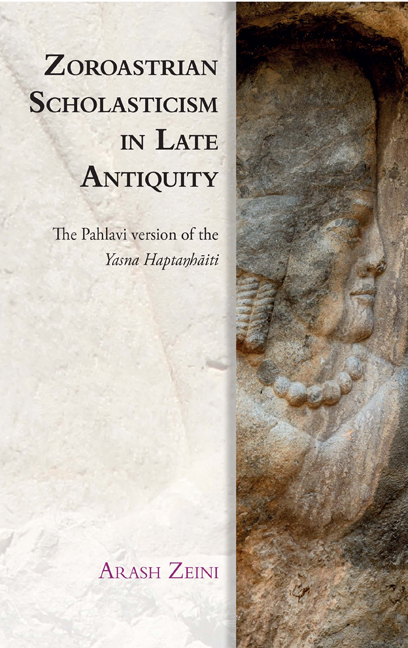Book contents
- Frontmatter
- Contents
- List of Figures
- List of Tables
- Acknowledgements
- Series Editor’s Preface
- Preface
- Conventions
- Abbreviations
- Dedication
- Part I Introduction
- 1 Introduction
- 2 The Zand
- 3 Scholasticism
- 4 Fire in Zoroastrianism
- 5 Precis: Yasn Ī Haft Hād
- Part II Text and translation
- 6 PY 35
- 7 PY 36
- 8 PY 37
- 9 PY 38
- 10 PY 39
- 11 PY 40
- 12 PY 41
- Part III Miscellaneous Observations
- 13 PY
- 14 PY 36
- 15 PY 37
- 16 PY 38
- 17 PY 39
- 18 PY 40
- 19 PY 41
- Part IV Epilogue
- 20 Reflections on the Zand
- Appendices
- Appendix A Transliteration and Apparatus
- Appendix B Y 9.1
- Appendix C Fire in the Older Avesta
- Appendix D Iϑā
- Appendix E MSS Concordance
- Bibliography
- Index of Passages Quoted
1 - Introduction
Published online by Cambridge University Press: 14 October 2020
- Frontmatter
- Contents
- List of Figures
- List of Tables
- Acknowledgements
- Series Editor’s Preface
- Preface
- Conventions
- Abbreviations
- Dedication
- Part I Introduction
- 1 Introduction
- 2 The Zand
- 3 Scholasticism
- 4 Fire in Zoroastrianism
- 5 Precis: Yasn Ī Haft Hād
- Part II Text and translation
- 6 PY 35
- 7 PY 36
- 8 PY 37
- 9 PY 38
- 10 PY 39
- 11 PY 40
- 12 PY 41
- Part III Miscellaneous Observations
- 13 PY
- 14 PY 36
- 15 PY 37
- 16 PY 38
- 17 PY 39
- 18 PY 40
- 19 PY 41
- Part IV Epilogue
- 20 Reflections on the Zand
- Appendices
- Appendix A Transliteration and Apparatus
- Appendix B Y 9.1
- Appendix C Fire in the Older Avesta
- Appendix D Iϑā
- Appendix E MSS Concordance
- Bibliography
- Index of Passages Quoted
Summary
Was diese Stücke so schwierig macht, ist das Vage ihres Inhaltes. Sie bewegen sich immer in Gefühlen der allgemeinsten Art und es ist unendlich schwierig einen leitenden Gedanken zu entdecken, der durch ein ganzes Capitel geht.
Spiegel (1859: viii) on Zand.THE YASNA HAPTAŊHĀITI
The Yasna Haptaŋhāiti ( YH) is a ritual text arranged in seven hāiti (‘chapter’ or ‘division’) and composed in a language identical in grammar and phono- logy to the Old Avestan of the Gāϑās (Narten 1986: 20). It is embedded in the text of the Yasna ( Y) ritual, beginning with Y 35 and ending with Y 41. As the Yasna is commonly divided into 72 hāiti, the Yasna Haptaŋhāiti is thus positioned right at the centre of one of Zoroastrians’ most significant daily rituals. In an attempt to define the ritual properties of the text with familiar terms, Narten (1986), Boyce (1992) and Hintze (2002, 2009a) suggest that the YH was the liturgical kernel text of the Yasna ritual.
Although the question as to whether the figure of Zaraϑuštra represents the Gāϑic poet, a generic poet sacrificer or the founder of the religion may seem anachronistic today, it has shaped previous scholarship. Narten (1986: 35–7), for instance, considers the attribution of the YH to Zaraϑuštra, a view shared by Boyce (1992, 1997b, 2001) and Hintze (2007a). Schwartz, however, regards the YH as slightly younger than the Gāϑās and disagrees with the supposition of Zaraϑuštra's authorship. Kellens and Pirart (1988: 36–9) consider the YH to resemble the Gāϑās in language and estimated date of composition, but dispute Zaraϑuštra's authorship as well. Unlike Schwartz, they propose a competing ‘l’école haptahâtique’, which supposedly did not recognise Zaraϑuštra as its religious leader (Kellens and Pirart 1988: 39). Humbach (1991: 7) does not address the authorship of the YH and merely notes that it originates ‘from the period of the early Mazdayasnian church’. Despite disagreements over such details, a consensus exists on the proximity of the YH to the Gāϑās. The priestly tradition has preserved Zaraϑuštra as the name of the Gāϑic poet, and while various YAv. passages suggest that the YH was recognised as a sacred text (Narten 1986: 17), we are unaware of any traditional attribution of the YH to Zaraϑuštra.
- Type
- Chapter
- Information
- Zoroastrian Scholasticism in Late AntiquityThe Pahlavi Version of the Yasna Haptaŋhāiti, pp. 3 - 27Publisher: Edinburgh University PressPrint publication year: 2020



